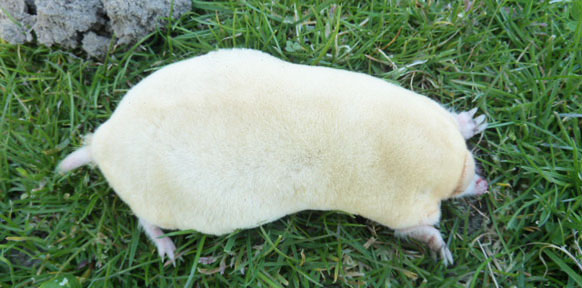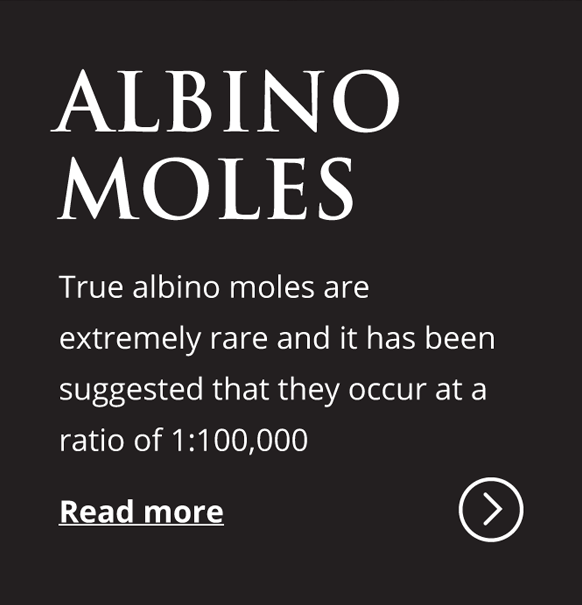
Mole Research
In all, about 180 scientific papers have been published on the biology of various mole species since 1980, but at an average rate of only six papers a year these animals remain little studied. Scientific observation of moles only really started in the twentieth century but through its first 50 year’s research efforts were limited to basic observations of mole’s nests, anatomy, digging and breeding habits.
Edited extract taken with kind permission from ‘Moles’ by Rob Atkinson, published by Whittet Books, 2013. Recommended reading.
Interesting recent research, that has been carried out on a mammal rarely researched includes:
How mole eyesight could help humans
Dr Martin Collinson from the University of Aberdeen has made some important discoveries regarding the evolution of the eye. He has discovered that a type of stem cell in our retinas could hold the key to repair them after disease or injury that could lead to blindness. He found that although they are inactive in humans, in moles they are active.
Dr Collinson identified that moles have fully developed retinas, which have the correct cell types to detect light and also make the correct connections with their brains. He proved that moles have masses of a specialised type of retinal cell that is needed to control body clocks.
“We should have listened to the country folk, because as any mole catcher knows, moles get up in the morning, have a nap in the middle of the day and then get active again in the evening, before bed.”
His work has shown that a partially formed eye is inherently important for the ecology and survival of an animal and therefore, nothing is impossible regarding the evolution of the eye.
Dr Collinson quoted; “If we could work out how moles do that, we would hold a key to human retinal repair”, and that is very exciting indeed.
Penis Size Matters to female Golden Moles
The female Hottento golden Moles, which are not close relatives of Talpa europea, although similar in appearance live in sub Saharan-Africa.
The females use the size of male golden moles’ penis as a guide to their suitability as a mate. This suggests that a long penis makes the male mole more attractive and is therefore a sexually selected trait in this species.
The study was conducted by Prof Nigel Bennet, University of Pretoria, South Africa with Ms Tarryn Retief and Dr Bill Bateman.
Prof Bennet suggests, “We know very little about their mating strategy. Suffice to say it’s probably every mole for himself.”
Dr Bateman concluded, “We think that penis size matters for these essentially solitary creatures, more or less blind, underground dwellers. Judging penis size when mating may be one of the only criteria they have available to them.”
Published in the journal Mammalian Biology
Mystery of mole’s second thumb solved
Moles get two big thumbs-up for their digging skills. They have what looks like a sixth digit on each front paw, while most land based vertebrates have to 10. In 2011, a study of embryonic moles showed that this doppelganger thumb is no thumb at all, but a co-opted wrist bone that starts to elongate relatively late in development.
Although not as famous as the panda’s similar extra thumb, a heavy tool for grasping bamboo, the mole’s sixth digit is an evolutionary curiosity. This thumb, a solid piece of bone on the outside of the hand that can wiggle but not bend, certainly seems useful. The extra bone widens the mole’s spatulate paws, creating a super scooping tool, enabling them to move huge volumes of earth. Primitive mole species less inclined to tunnel-building tend to have stubbier second thumbs.
To unearth whether the mole is an evolutionary rule-breaker, Marcelo Sánchez, an evolutionary biologist at the University of Zürich in Switzerland, and colleagues went back to the thumb’s beginnings. The team compared the stubby and fingerless limbs of embryonic Iberian moles (Talpa occidentalis) with the limbs of closely related shrew embryos, looking for molecular clues to early digit growth.
One such clue, a gene called Sox9 that often turns on before bone growth, clearly identified the would-be digit as a finger impostor. Sox9 didn’t kick into gear at the site of the future second thumb until the mole embryos were 18 days old, after the gene’s activity had peaked in the true fingers. “It forms like a finger forms but later”, Sánchez said.
But more importantly, the second thumb forms at the wrong place – not in the limb tissue reserved for growing fingers but where the wrist should be. “The digit is actually a wrist bone”, Sánchez says. Over evolutionary time, it extended like a claw until it reached the other fingers.
Hands haven’t always been limited to five fingers. Nearly 400 million years ago, the earliest land vertebrates could have given each other high-sixes, sevens, and even eights, not just fives, to celebrate leaving the oceans. But over tens of millions of years, creatures with seven and eight fingers died off, leaving only their five-fingered brethren behind. “Moles couldn’t break the precedent, but they could sneak around it”, Sánchez says.
Testosterone may be partly responsible. “True to their oddness, many female moles grow not only ovaries but also some testicular tissue, hinting that they have too much of the hormone”, Sánchez says. Testosterone is well known for building bones, and some evidence suggests that human polydactyly – people can occasionally develop genuine sixth fingers – coincides with high levels of maternal testosterone.
The study is “a very exciting development”, says Robert Asher, an evolutionary biologist at the University of Cambridge in the United Kingdom. But he cautions that scientists have a way to go before they know all the details of how the second thumb develops.
At British Mole Catchers, we welcome connecting with research professionals to enhance future understanding of the mole in order to understand and further advance all scientific knowledge.







